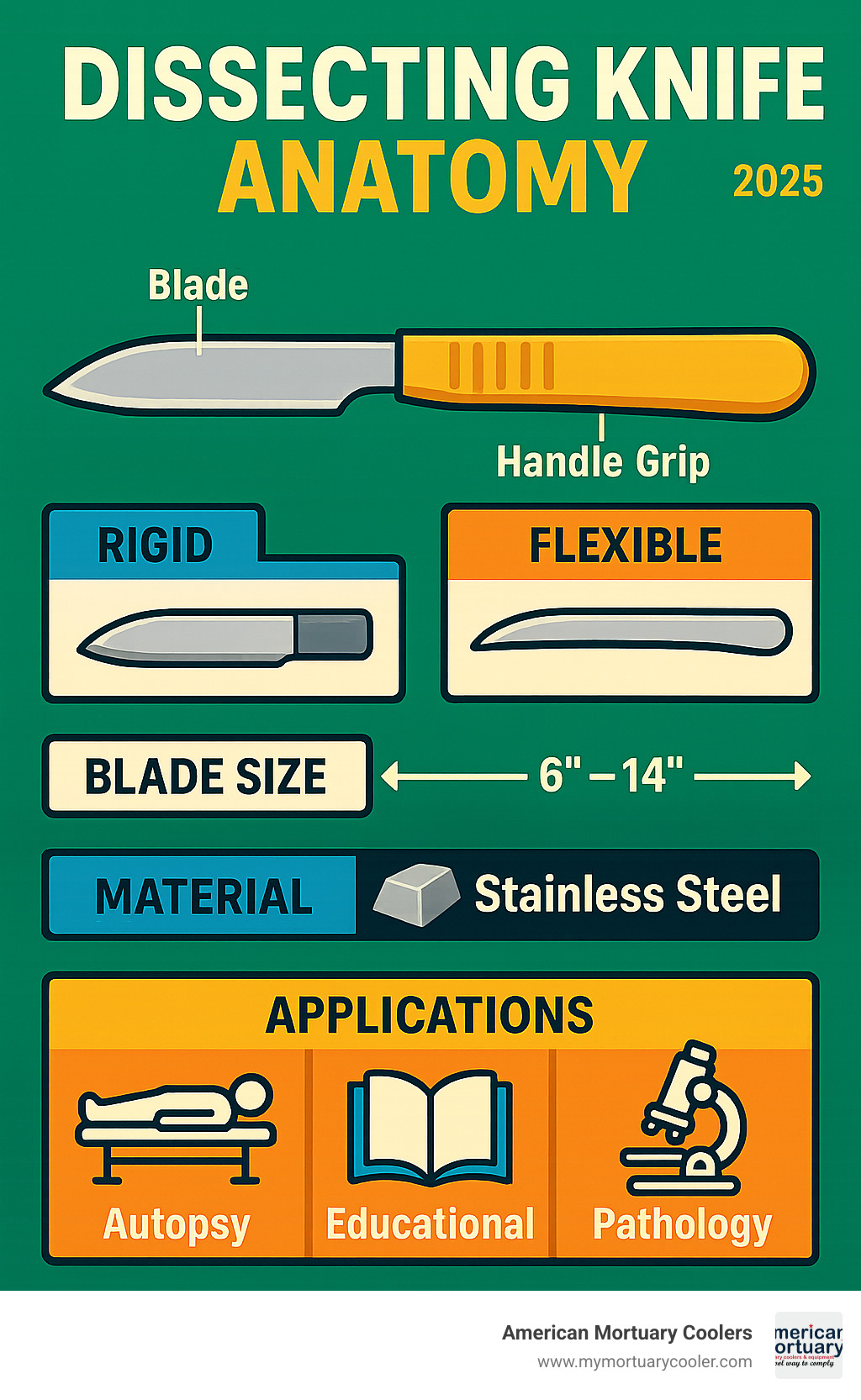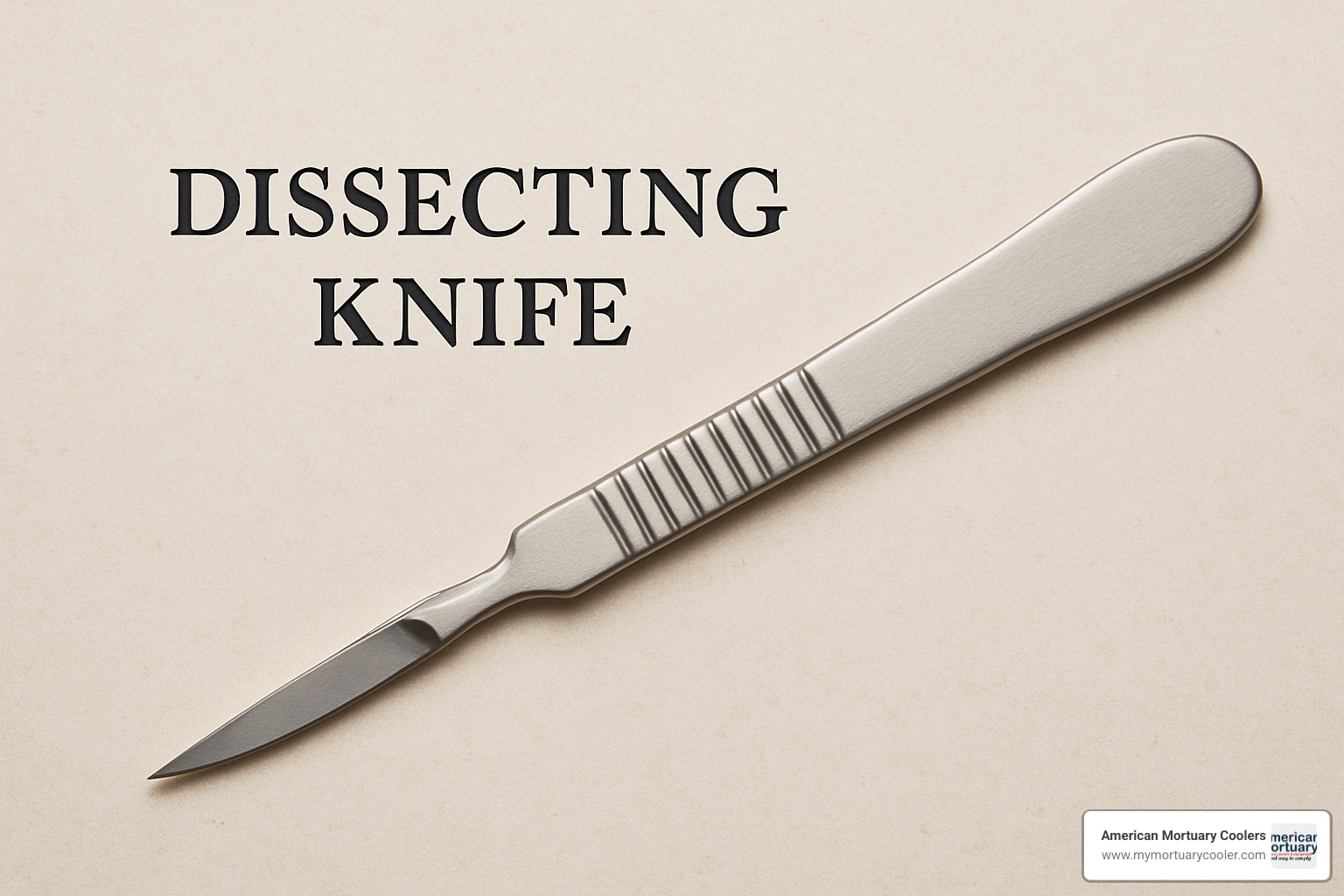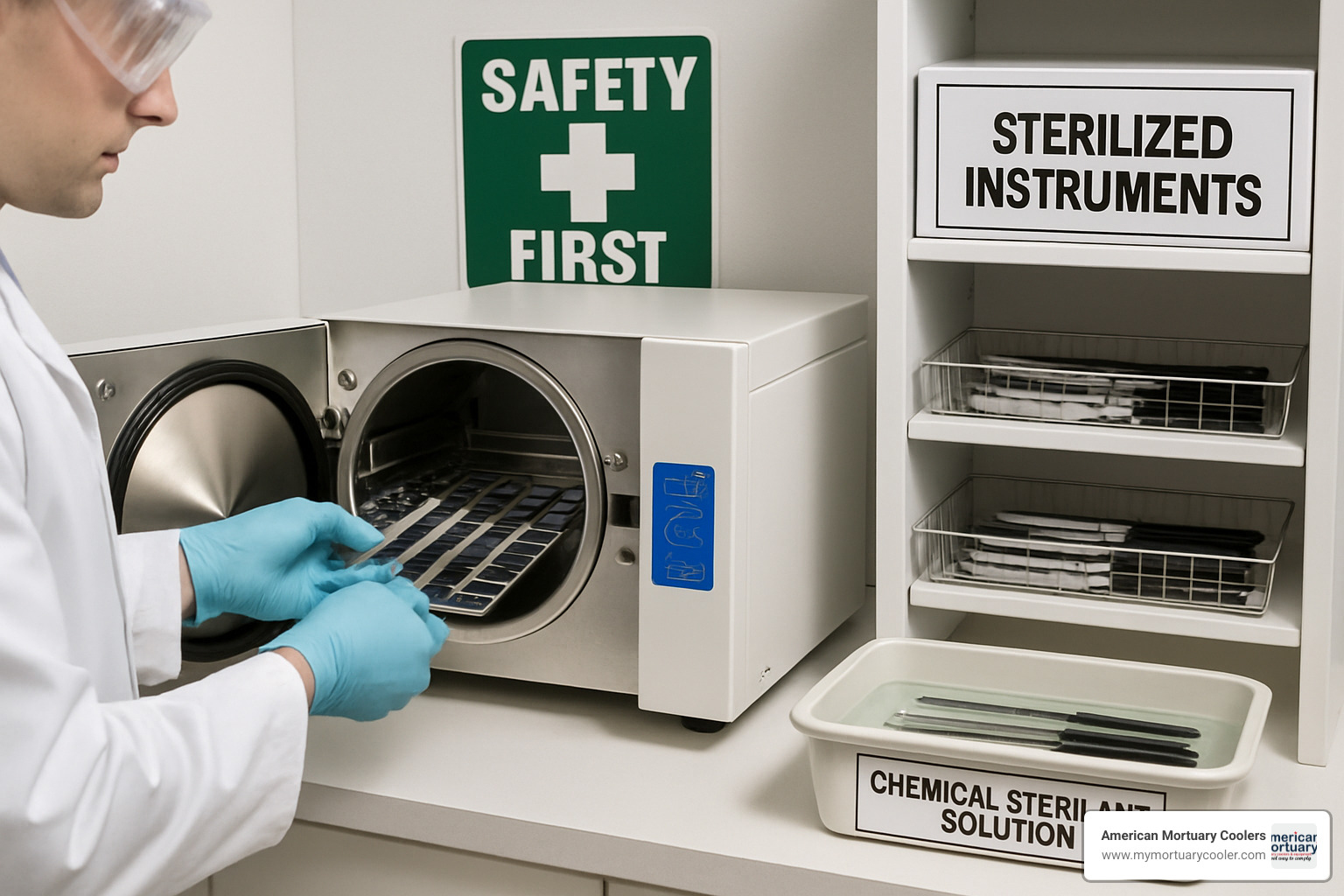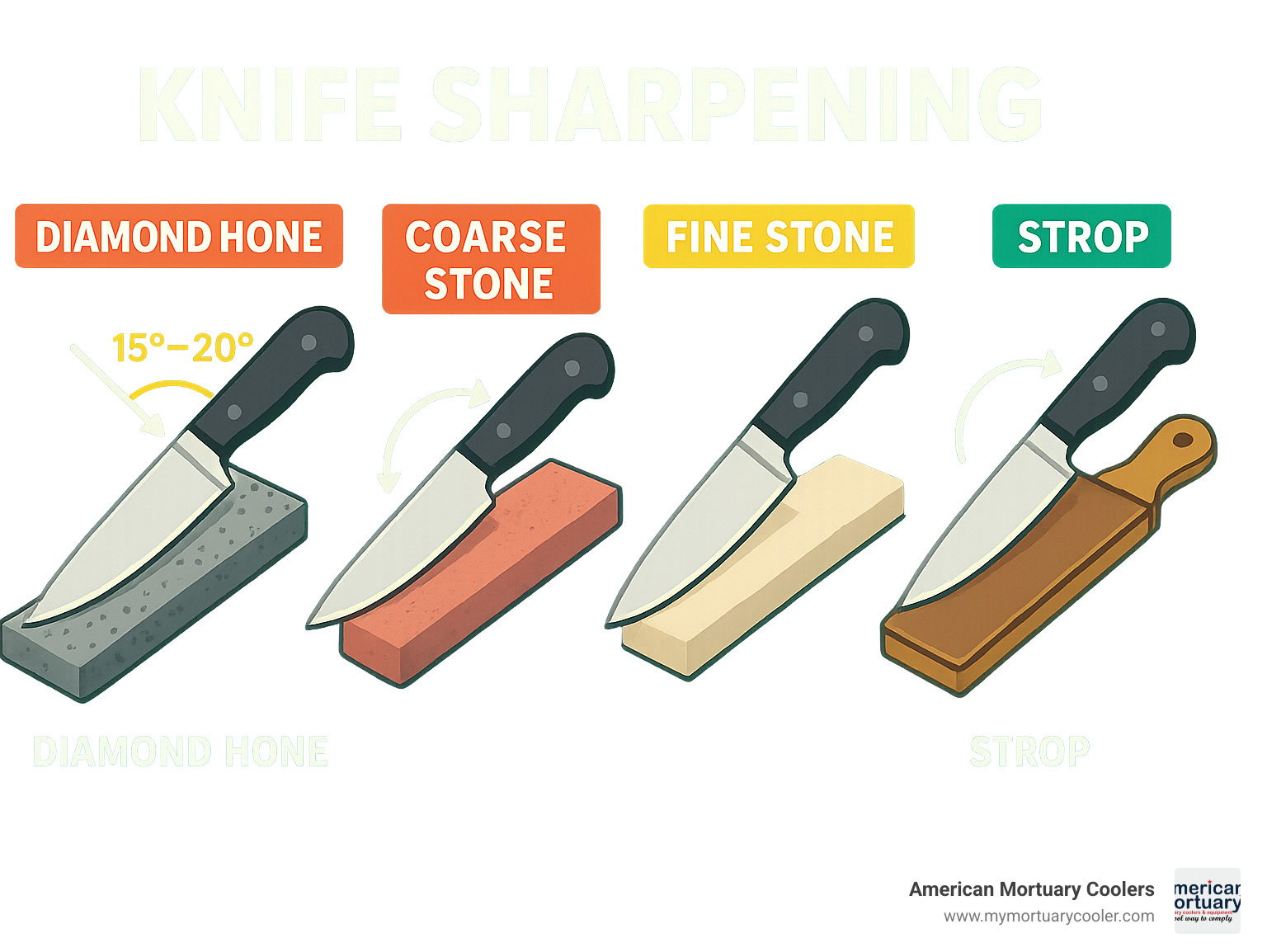Why Choosing the Right Dissecting Knife Matters for Your Facility
A dissecting knife is a specialized surgical instrument with a sharp, precise blade designed for anatomical dissection, autopsy procedures, and educational laboratory work. Unlike standard scalpels, dissecting knives feature longer blades (typically 6-14 inches) and are built for continuous use rather than single procedures.
Key dissecting knife specifications:
- Blade lengths: 6" to 14" (150mm to 356mm)
- Materials: Premium stainless steel construction
- Types: Rigid, flexible, heavy-pattern, and disposable models
- Applications: Autopsy, gross pathology, veterinary necropsy, educational labs
- Price range: $20-$280 depending on quality and features
Whether you're outfitting a funeral home preparation room, pathology lab, or educational facility, the right dissecting knife can mean the difference between clean, professional work and frustrating, imprecise cuts that waste time and compromise results.
Modern dissecting knives come in various configurations - from lightweight 13cm student models with 1mm blades for delicate work, to heavy-duty German autopsy knives with hollow-ground edges that maintain their sharpness through repeated use. Professional models like the Mopec AH101 feature 11¾" blades specifically engineered for continuous sharpening, while flexible 14" models excel at smooth, long sectioning cuts.
I'm Mortuary Cooler, and over my years supplying mortuary equipment nationwide, I've seen how the right dissecting knife tools can streamline operations and improve service quality for funeral directors and pathology professionals. My experience helping facilities choose durable, American-crafted instruments has shown me exactly what features matter most when selecting dissecting knife equipment for long-term reliability.

Know your dissecting knife terms:
Dissecting Knife 101 – Types, Designs & Key Specifications
Dissecting knives aren't just oversized scalpels. These specialized instruments are built for continuous cutting without losing their edge or compromising precision.
The most obvious difference is size. While scalpels typically measure 1-2 inches, dissecting knives stretch from 6 inches all the way up to 14 inches. That extra length provides the reach and leverage needed for smooth, uninterrupted cuts through large specimens.
What sets professional dissecting knives apart is their hollow-ground edge design. This manufacturing technique creates a blade you can sharpen repeatedly while maintaining precise cutting angles. Compare that to disposable scalpels, and you'll see why serious facilities invest in quality dissecting knives.
Construction matters too. Premium German stainless steel has become the gold standard because it handles repeated autoclave cycles without dulling or corroding. When you're sterilizing instruments multiple times daily, that durability pays for itself quickly.
You'll encounter several design variations. Rigid blades give maximum control for precise cuts through dense tissue, while flexible blades excel for smooth, continuous sectioning work. Heavy pattern models feature thick top edges (around 1/16" or 1.6mm) that can withstand mallet strikes for bone cutting. Right-angle designs are lifesavers when accessing tight spaces during detailed dissection.
Professional models like the Mopec AH014 showcase these principles perfectly - its 14" flexible blade handles long, continuous cuts beautifully, while the German Autopsy Dissecting Knife (AH101) offers an 11-3/4" blade specifically engineered for continuous sharpening.
| Feature | Scalpel | Dissecting Knife |
|---|---|---|
| Blade Length | 1-2 inches | 6-14 inches |
| Primary Use | Single procedures | Continuous dissection |
| Edge Design | Disposable sharp | Hollow-ground, sharpenable |
| Handle Type | Detachable | Integrated or ergonomic grip |
| Cost per Use | Higher (disposable) | Lower (reusable) |
Main Types of Dissecting Knife
The dissecting knife world offers several specialized tools, each designed with specific applications in mind.
Primary dissecting knives are your everyday workhorses. These typically feature 8-12 inch rigid blades that maintain consistent performance whether you're working with soft tissue or tougher specimens. They're the reliable choice for general autopsy and pathology work.
Post-mortem knives take things up a notch. Models like the double-edge postmortem knives are specifically engineered for funeral home and morgue applications, offering superior control during embalming preparation when precision matters.
When research demands perfect, uninterrupted cuts, specimen long knives shine. The 14" flexible models let pathologists create clean sections in one smooth motion - no stopping and starting that can compromise sample quality.
Disposable prep knives solve a different problem entirely. Available in convenient 10-packs, they eliminate sterilization time while maintaining professional cutting quality. Perfect for high-volume facilities where efficiency trumps reusability.
For tough jobs, heavy bone-cutting models feature reinforced construction with thick top edges designed to handle mallet strikes. These are indispensable when you need to complete thorough anatomical dissections involving bone cutting.
The McCabe Flap Knife represents specialized engineering - a double-ended design with 20/45° angles and 2x3.5mm blade separation that offers exceptional versatility for delicate tissue work.
Essential Specs Every Dissecting Knife Buyer Should Know
When evaluating any dissecting knife, certain specifications can make or break your experience.
Blade width and thickness directly impact cutting precision. Professional models typically feature 1mm blade thickness for fine work, giving you the control needed for detailed dissection. Heavy-duty versions may exceed 1.6mm when durability takes priority over delicate work.
Don't overlook handle grip compatibility - your hands will thank you during long dissection sessions. The AJ500 Ergo-Gross grip system and AJ501 foam grips can transform a standard handle into an ergonomic tool that reduces operator fatigue and improves dexterity.
German steel construction remains the gold standard for good reason. It offers superior hardness and corrosion resistance compared to standard stainless steel alternatives. When making a long-term investment, this quality difference becomes obvious over time.
Autoclave safety isn't negotiable for professional applications. Make sure your chosen knife can withstand repeated sterilization cycles without blade quality degrading or handle integrity compromising.
Size specifications matter more than most people realize. Dissecting knives are commonly available in 15cm, 15.5cm, 16cm, and 17cm lengths to suit different anatomical and laboratory applications. This variety ensures you can match the tool precisely to your facility's specific needs rather than making do with a one-size-fits-all approach.
How to Choose the Right Dissecting Knife for Your Needs
Finding the perfect dissecting knife isn't about picking the shiniest one in the catalog. After years of helping facilities across Tennessee, Georgia, Illinois, and beyond outfit their preparation rooms, I've learned that the best knife matches exactly what you're doing with it.
Application matching is where most people get it wrong. The knife that works beautifully for student anatomy labs might feel clunky in a professional autopsy suite. Autopsy work needs different blade characteristics than classroom dissections - it's like comparing a chef's knife to a paring knife.
Think about tissue hardness too. Soft tissue work flows better with flexible blades that bend and follow natural curves. But when dealing with dense tissue or cutting through tougher materials, you want a rigid, heavy-pattern design that won't flex under pressure.
The educational versus professional divide creates two different worlds of requirements. Student models prioritize safety and forgiveness - they're designed for people still learning proper technique. Professional instruments focus on precision and durability for operators who know exactly what they're doing and need tools that perform consistently day after day.
Kit compatibility matters more than you might think. If you're building a comprehensive setup around a basic 23-piece dissection kit with scalpels, forceps, scissors, and probes, make sure your dissecting knife choice plays well with those existing tools.
Price ranges tell their own story. Student models start around $20-35 for basic functionality. Professional German autopsy knives can reach $280, but that premium pays for specialized features and construction quality that justifies itself over years of use.
Reputable brands matter in this business. You want companies that understand the demanding requirements of mortuary and pathology work. Warranty coverage becomes crucial when investing in professional-grade instruments that need to perform reliably.
More info about Beginners Dissection Kits

Student vs Standard vs Professional Models
Budget-friendly student models typically feature 13cm lengths with basic stainless steel construction. These instruments prioritize safety with rounded tips and moderate sharpness that reduces accident risk while students learn proper handling techniques.
The beauty of student models isn't in their simplicity - it's in their forgiveness. New users make mistakes, and these knives are designed to minimize the consequences of those learning moments.
Mid-tier standard models hit the sweet spot for many facilities. They offer significantly improved materials and construction quality without the premium price tag. These represent the workhorses of the industry - reliable, durable, and capable of handling most applications without breaking the bank.
Premium professional instruments justify their higher cost through superior materials, precision manufacturing, and specialized features that matter in demanding applications. The continuous sharpening capability of hollow-ground edges means these knives actually become more cost-effective over time because they maintain their performance longer.
Ergonomic considerations become increasingly critical with professional use. Extended dissection sessions demand comfortable grips that prevent hand fatigue and maintain precise control throughout lengthy procedures.
Top Brands & Where to Buy
Mopec has earned its reputation as the go-to choice for professional applications. Their German Autopsy Dissecting Knife (AH101) sets the standard that other manufacturers try to match. When funeral directors and pathologists need instruments they can count on, Mopec consistently delivers.
Swann-Morton brings precision manufacturing that educational institutions and research facilities worldwide have trusted for decades. Their attention to detail shows in every blade.
Fisher Scientific bridges the gap between budget and professional markets with reliable instruments and an extensive distribution network that serves laboratories and educational facilities efficiently.
Online marketplaces offer competitive pricing and detailed specifications, though you miss the chance to handle the instrument before buying. For experienced users who know exactly what they want, this works well.
Local surgical supply companies provide personal consultation and immediate availability. They often service what they sell, which can be invaluable when you need quick repairs or replacements.
The advantage of working with established suppliers is their understanding of your specific needs. They can guide you toward instruments that will serve your facility well for years to come.
Scientific research on ergonomic-handles
Safe Handling, Maintenance & Sterilization Best Practices
Working with a dissecting knife safely starts before you even pick up the instrument. Your personal protective equipment isn't optional - it's your lifeline. Cut-resistant gloves should be your best friend, along with safety goggles and protective clothing. I've seen too many preventable accidents happen when someone thought they could skip the basics.
Blade changes deserve your full attention and respect. These aren't kitchen knives you can casually handle. Always use proper blade removal tools and never try to do it by hand. When you're done, those contaminated blades go straight into designated sharps containers - never regular trash. Your facility's disposal protocols aren't suggestions; they're requirements that keep everyone safe.
Autoclave sterilization is the gold standard for dissecting knife maintenance. Most facilities run cycles at 134°C (273°F) for 18 minutes, though your specific protocols might vary based on your knife's construction materials. When autoclaving isn't practical, chemical sterilants work well, but they need longer contact times and proper ventilation to be effective.
Keeping your blade sharp isn't just about performance - it's about safety too. Dull blades require more pressure and are more likely to slip. Diamond hones and multi-edge sharpeners like the AH120 Multi-Edge Diamond Hone help maintain that precise cutting edge between major sharpenings. And don't forget storage sheaths - they protect both your blades and your fingers when the knife isn't in use.
More info about scalpel maintenance


Step-by-Step Cleaning & Sharpening Routine
A proper cleaning routine for your dissecting knife starts with a pre-rinse using lukewarm water. Hot water might seem better, but it actually makes proteins coagulate on the blade surface, making your job harder later.
Next comes enzymatic soaking, which breaks down organic matter that scrubbing alone might miss. Follow the manufacturer's recommendations for concentration and contact time - more isn't always better, and you don't want to damage your expensive instruments.
Ultrasonic cleaning takes care of those hard-to-reach spots, especially important if your dissecting knife has textured grips or complex handle designs. This step ensures you're getting truly clean instruments, not just ones that look clean.
When it comes to sharpening, diamond hone work maintains that crucial hollow-ground edge geometry that makes professional dissecting knives so effective. Work through progressively finer grits - patience here pays off in performance later.
The final strop finishing step polishes the edge to surgical sharpness and removes any tiny burrs left by the honing process. This is what separates professional-quality maintenance from basic sharpening, and your cuts will show the difference.
Critical Safety Precautions in the Lab
Proper grip technique isn't just about comfort - it's about control. Your dissecting knife should always be completely under your command, never allowed to move freely or unpredictably. A good grip prevents slippage and keeps everyone around you safe.
The cut-away technique is non-negotiable. Always direct blade movement away from your body and other people. Never cut toward yourself, no matter how convenient it might seem in the moment. I've helped too many facilities deal with accidents that could have been prevented by following this simple rule.
Never point your dissecting knife at people or use it to indicate anatomical features. It might seem obvious, but in the middle of a complex procedure, it's easy to forget basic safety protocols.
Keep a first-aid kit accessible and properly stocked. Every facility using dissecting knives should have trained personnel and emergency supplies ready to go. Hope you never need them, but be prepared if you do.
Supervision requirements matter, especially for inexperienced users. Don't let anyone work with these instruments alone until they've demonstrated safe handling skills under qualified oversight. Your facility's reputation and everyone's safety depend on maintaining these standards.
Top 7 Dissecting Knives Worth Your Money in 2024
Based on our extensive experience supplying mortuary and laboratory equipment, these dissecting knife models represent the best value and performance in their respective categories:
1. Mopec German Autopsy Knife (AH101) - $180-220
- 11¾" (300mm) hollow-ground blade
- Continuous sharpening capability
- Professional autopsy standard
- Pros: Exceptional edge retention, balanced design
- Cons: Higher initial cost, requires proper maintenance
2. Flexible 14" Long Specimen Knife (AH014) - $160-200
- Excellent for smooth, continuous sectioning
- Flexible blade conforms to tissue contours
- Ideal for pathology applications
- Pros: Superior cutting smoothness, versatile applications
- Cons: Requires skill to control flexibility
3. Heavy Pattern Large Grossing Knife (AH110) - $190-240
- 14" heavy-duty construction
- Thick top edge for mallet use
- Built for demanding applications
- Pros: Exceptional durability, handles tough tissue
- Cons: Weight may cause fatigue, premium pricing
4. Student Right-Angle Knife (13cm) - $35-50
- 1mm blade thickness for precision
- Right-angle design for confined spaces
- Perfect for educational settings
- Pros: Affordable, safe for beginners, precise control
- Cons: Limited to light-duty applications
5. McCabe Flap Knife & Dissector - $45-65
- 7.25" double-ended design
- 20/45° angles with 2x3.5mm separation
- Premium German stainless steel
- Pros: Versatile angles, quality construction, reasonable price
- Cons: Specialized application, learning curve required
6. Disposable Grossing Prep Knives (10-pack) - $80-120
- Convenient single-use design
- Eliminates sterilization requirements
- Consistent performance across pack
- Pros: No maintenance, always sharp, time-saving
- Cons: Higher per-use cost, environmental considerations
7. Gannetts Post Mortem Knife (AH015) - $140-180
- 10" traditional design
- Optimized for funeral home applications
- Balanced weight distribution
- Pros: Proven design, comfortable handling, mortuary-specific
- Cons: Limited versatility, traditional styling
Quick-Glance Comparison Chart
| Model | Length | Rigidity | Best Use | Price Range | Rating |
|---|---|---|---|---|---|
| Mopec AH101 | 11¾" | Rigid | Professional Autopsy | $180-220 | ⭐⭐⭐⭐⭐ |
| Flexible AH014 | 14" | Flexible | Specimen Sectioning | $160-200 | ⭐⭐⭐⭐⭐ |
| Heavy AH110 | 14" | Heavy-Duty | Bone/Dense Tissue | $190-240 | ⭐⭐⭐⭐ |
| Student 13cm | 13cm | Moderate | Education | $35-50 | ⭐⭐⭐⭐ |
| McCabe Flap | 7.25" | Rigid | Specialized Work | $45-65 | ⭐⭐⭐⭐ |
| Disposable Pack | Varies | Standard | High-Volume | $80-120 | ⭐⭐⭐ |
| Gannetts AH015 | 10" | Rigid | Funeral Homes | $140-180 | ⭐⭐⭐⭐ |
Frequently Asked Questions about Dissecting Knives
Let me address the most common questions I hear from funeral directors, pathologists, and educators when they're choosing dissecting knives for their facilities. These are the real-world concerns that come up time and again.
What is the difference between a dissecting knife and a scalpel?
Think of it this way - scalpels are like precision pencils, while dissecting knives are more like quality paintbrushes. The differences go far beyond just size, though that's the most obvious distinction.
Blade length tells the whole story. Scalpels typically measure just 1-2 inches, perfect for detailed surgical work where you need pinpoint control. Dissecting knives range from 6 inches all the way up to 14 inches, giving you the reach and cutting power needed for extended anatomical work.
Construction philosophy differs completely between the two. Scalpels are designed around disposable blades - you use them once and throw them away. Dissecting knives feature hollow-ground, sharpenable blades that actually improve with proper maintenance over years of use.
The intended applications couldn't be more different either. Scalpels excel in operating rooms where precision trumps everything else. Dissecting knives shine in autopsy suites, pathology labs, and educational settings where you're making long, continuous cuts through varied tissue types.
Cost-wise, scalpels seem cheaper upfront but those disposable blades add up fast. A quality dissecting knife like the Mopec AH101 costs more initially but pays for itself through years of reliable service.
How do I keep my dissecting knife sharp and rust-free?
Here's where many facilities go wrong - they treat dissecting knives like disposable tools instead of the precision instruments they are. Proper maintenance isn't complicated, but it does require consistency.
Immediate cleaning after each use prevents the biggest problems. Rinse with lukewarm water first - hot water actually sets proteins and makes cleaning harder. Follow up with enzymatic cleaners that break down organic matter naturally.
Thorough drying is absolutely critical. Even the best stainless steel will corrode if you store it wet. I've seen expensive German knives ruined because someone put them away damp.
Sharpening technique makes all the difference with hollow-ground blades. Start with a coarser diamond hone to restore the edge, then progress through finer grits. The key is maintaining that original hollow-ground angle - it's what makes professional dissecting knives so effective.
Storage matters more than most people realize. Use protective sheaths or designated holders that keep blades separated and protected. For long-term storage, a light coat of machine oil prevents rust formation without affecting performance.
The beauty of professional models like the Mopec series is they're engineered for continuous sharpening. With proper care, these knives actually become more cost-effective the longer you use them.
Which blade length is best for autopsy vs classroom dissections?
This question comes up constantly, and the answer depends entirely on your specific applications and user experience levels.
Autopsy work demands longer blades for good reason. When you're working with full-sized human anatomy, those 11-14 inch blades let you make smooth, continuous cuts without constantly repositioning. The Mopec AH101 with its 11¾" blade didn't become the professional standard by accident - it's perfectly sized for efficient autopsy procedures.
Classroom dissections work better with shorter, more manageable lengths. Those 6-10 inch blades give students better control while reducing accident risk. The 13cm student models we recommend offer that sweet spot between functionality and safety that educators appreciate.
Specimen size should drive your decision more than anything else. Small animal dissections in biology classes work fine with shorter blades. Large animal necropsy or human pathology work needs the reach that longer blades provide.
User experience factors in heavily too. Experienced pathologists can handle 14-inch flexible blades with ease, making smooth sectioning cuts that would be impossible with shorter tools. Students and occasional users benefit from shorter, more forgiving designs that don't require years of practice to master safely.
The reality is most facilities end up with multiple dissecting knife lengths to handle different situations. It's not about finding one perfect size - it's about matching the right tool to each specific application.
Conclusion & Next Steps
Finding the perfect dissecting knife isn't just about making a purchase - it's about investing in the precision and professionalism that defines your facility's reputation. Whether you're running a funeral home in Tennessee, managing a pathology lab in Georgia, or teaching anatomy students across our service regions, the right cutting instruments become an extension of your expertise.
At American Mortuary Coolers, we've built our reputation on understanding what mortuary professionals really need. Just like our custom mortuary coolers that keep running reliably for decades, the dissecting knives we've covered represent that same commitment to long-term performance and professional excellence.
Over the years serving facilities from Johnson City, TN to Los Angeles, CA, we've learned that quality equipment isn't an expense - it's an investment. That German autopsy knife that costs $200 today will still be delivering precise cuts years from now, while cheaper alternatives get replaced repeatedly.
Getting started is straightforward. First, take an honest look at what you're actually doing day-to-day. Are you primarily handling soft tissue work that needs flexibility, or dealing with dense materials that require heavy-duty construction? Your specific applications should drive every decision.
Budget planning goes beyond the sticker price. That professional-grade Mopec knife might seem expensive upfront, but factor in the maintenance costs and replacement frequency of cheaper alternatives. Quality instruments actually save money over time.
Finding reliable suppliers matters. Work with distributors who understand mortuary and pathology needs, not just general medical supply companies. You want someone who can answer detailed questions about hollow-ground edges and autoclave compatibility.
Training your team properly protects everyone involved. Even the best dissecting knife becomes dangerous in untrained hands. Make sure everyone understands proper grip techniques, cut-away methods, and safe storage procedures.
Maintenance planning keeps everything running smoothly. Set up regular sharpening schedules, establish sterilization protocols, and keep proper storage equipment on hand. A well-maintained knife performs better and lasts longer.
The mortuary and pathology fields don't allow for second chances. When families trust you with their loved ones, or when research depends on your precision, having reliable instruments becomes absolutely critical. That's the same philosophy that drives our mortuary cooler manufacturing - build it right the first time, and it'll serve you faithfully for years.
Ready to upgrade your dissection capabilities? Our team brings the same attention to detail and commitment to durability that has made us leaders in custom mortuary equipment across the contiguous 48 states.
















